Social Security Disability benefits are crucial for individuals who can no longer work due to a disabling condition. However, the application process for these benefits can be complex and challenging. Many applicants find themselves frustrated after receiving a denial, which can add to the financial stress they are already experiencing. Understanding the reasons why Social Security Disability claims are denied and how to avoid common pitfalls can help applicants strengthen their case and improve their chances of approval.
What is Social Security Disability?
This Article Includes [hide]
Social Security Disability Insurance (SSDI) is a federal program that provides financial assistance to people who are unable to work due to a physical or mental disability. To qualify for SSDI benefits, applicants must meet specific criteria, including demonstrating that their disability prevents them from engaging in substantial gainful activity. The process involves an evaluation by the Social Security Administration (SSA) to determine if the applicant meets these requirements.
Common Reasons for Denial of Disability Benefits
The SSA has strict guidelines for evaluating disability claims. Many initial applications are denied, but understanding the most common reasons for rejection can help applicants avoid mistakes in their submission and increase the likelihood of approval.
1. Insufficient Medical Evidence
One of the most common reasons for denial is a lack of sufficient medical evidence. The SSA requires thorough documentation to establish the severity and nature of the applicant’s disability. This includes medical records, test results, and reports from healthcare providers. Without up-to-date and detailed medical documentation, it can be difficult for the SSA to verify the applicant’s condition, leading to a rejection.
2. Duration of Disability
The SSA requires that the disability must either be permanent or last for at least one year. If the applicant’s condition is expected to improve in a shorter time frame, their application may be denied. It’s important to provide a clear diagnosis and prognosis to demonstrate that the disability is long-term or permanent.
3. Failure to Meet Medical Requirements
For an application to be approved, the disability must be severe enough to prevent the individual from working. If the SSA determines that the condition is not disabling—meaning it does not significantly limit the person’s ability to perform daily activities or work—the application will be rejected.
4. Refusal to Participate in Additional Evaluations
In some cases, the SSA may request additional medical examinations or evaluations to assess the severity of the disability. If the applicant refuses to comply with these requests or fails to attend scheduled evaluations, the SSA may consider this non-cooperation, leading to a denial of the claim.
5. Earnings Above the Limit
Disability benefits are intended for individuals who have significant limitations on their ability to work. If an applicant is earning above the SSA’s threshold for monthly income, their application may be denied. This rule is in place to ensure that benefits go to individuals who truly need financial support due to their inability to work.
How to Strengthen Your Disability Application
The disability application process is not only about proving that you have a condition; it’s about demonstrating that the condition severely limits your ability to work and function in daily life. Here are a few tips to increase your chances of a successful claim:
1. Gather Comprehensive Medical Records
Ensure that your application is supported by comprehensive and detailed medical documentation. Include recent evaluations, diagnostic test results, and statements from medical professionals who have treated your condition. The more evidence you can provide, the stronger your case will be.
2. Consult with Legal Experts
Disability claims can be complicated, and it may be helpful to consult with a disability attorney or advocate. These professionals are experienced in navigating the SSA’s requirements and can help you organize your medical documentation, prepare for any necessary evaluations, and ensure your application is complete.
3. Respond to Requests Promptly
If the SSA asks for additional information or evaluation, respond as quickly as possible. Delaying or refusing to cooperate can harm your case. Attend any required medical exams and submit all requested documents on time.
4. Appeal if Denied
If your application is denied, don’t lose hope. Many claims are denied initially, but you can appeal the decision. In the appeal process, you can submit new evidence, provide additional medical reports, or address any reasons the SSA cited for denial. Many applicants who appeal a rejection eventually succeed in securing benefits.
Understanding the Unique Nature of Disability Claims
It’s important to remember that each Social Security Disability case is unique. The SSA evaluates claims individually, considering factors such as the severity of the disability, the applicant’s medical history, and their ability to work. Even if two individuals have similar conditions, their cases may be decided differently based on these factors.
The application process can be overwhelming, but by understanding the common reasons for denial and taking steps to address them, applicants can improve their chances of success. If at first, you don’t succeed, there is an appeals process that allows you to submit additional information and give your claim a second chance.
Final Thoughts
While applying for Social Security Disability benefits can be challenging, knowing the reasons for denial and how to overcome them can make the process more manageable. It’s crucial to be diligent, gather the necessary documentation, and consult with legal professionals if needed. With persistence and the right approach, many individuals are ultimately successful in obtaining the disability benefits they need to support their lives.







Leave a Reply